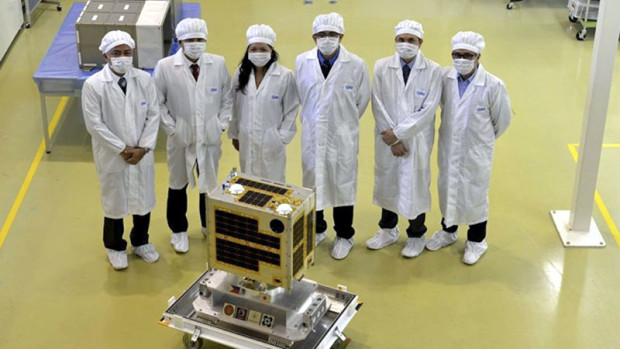Diwata-1 reaches int’l space station

SCIENTISTS from the University of the Philippines and Department of Science and Technology officials turn over Diwata, the first Filipino codeveloped microsatellite, to their counterparts at the Japan Aerospace Exploration Agency in Tsukuba City, Japan. CONTRIBUTED PHOTO
THE SPACECRAFT carrying Diwata-1 has reached the International Space Station (ISS) on Saturday night, marking the start of the month-long wait for the release into orbit of the country’s first microsatellite.
Orbital ATK’s Cygnus spacecraft, which was launched into space from Cape Canaveral Air Force Station in Florida on Wednesday, has successfully docked at the ISS at 10:52 p.m. on Saturday (Manila time), according to the National Aeronautics Space Administration’s (Nasa) website.
Diwata-1, officially named the Philippine Earth Observation Microsatellite, was among the 3,375-kilogram cargo of food, crew supplies, vehicle hardware and 20 nanosatellites on board the unmanned Cygnus spacecraft which was the fifth resupply mission to the ISS.
Carlos Primo David, executive director of the Department of Science and Technology’s (DOST) Philippine Council for Industry, Energy and Emerging Technology Research and Development, earlier said that the unloading process of Cygnus’ cargo would take some time.
Science Secretary Mario Montejo said that once Diwata-1 has been unloaded, it would be housed at the Japanese Experiment Module, nicknamed “Kibo,” where it would be released into orbit as early as April 20.
Once the country’s first Filipino-made and codeveloped microsatellite goes into orbit, it will stay in space for approximately 20 months at a distance of 400 kilometers from earth.
Diwata-1, developed by young University of the Philippines and DOST engineers, will be using its four specialized cameras to take an average of 3,600 high-resolution images of the country that will be used for imaging its land and water resources, and for studying changing weather patterns, agricultural productivity, as well as disaster response and mitigation.
Month-long dock
Nasa said that the Cygnus spacecraft—nicknamed SS Rick Husband in honor of the shuttle commander who died in the 2003 Space Shuttle Columbia accident—will be docked at the ISS for more than a month.
“Once it departs and the spacecraft is at a safe distance from the space station, engineers will remotely conduct the first Saffire experiment before the Cygnus’ destructive reentry into Earth’s atmosphere. Before detaching from the station, Cgynus will also be filled with about 3,000 pounds of trash, which will be burned up over the Pacific Ocean,” the space agency said in a statement.
The Saffire experiment, according to Nasa, is a “new way to study a large fire on an exploration craft, which has not been possible in the past because the risks for performing such studies on spacecraft with astronauts aboard are too high.”














